
Castle Howard is a stately home in North Yorkshire, England, within the civil parish of Henderskelfe, located 15 miles (24 km) north of York. It is a private residence and has been the home of the Carlisle branch of the Howard family for more than 300 years. Castle Howard is not a fortified structure, but the term "castle" is sometimes used in the name of an English country house that was built on the site of a former castle.

Belton House is a Grade I listed country house in the parish of Belton near Grantham in Lincolnshire, England, built between 1685 and 1687 by Sir John Brownlow, 3rd Baronet. It is surrounded by formal gardens and a series of avenues leading to follies within a larger wooded park. Belton has been described as a compilation of all that is finest of Carolean architecture, said to be the only truly vernacular style of architecture that England had produced since the Tudor period. It is considered to be a complete example of a typical English country house; the claim has even been made that Belton's principal façade was the inspiration for the modern British motorway signs which give directions to stately homes.

Earl of Onslow, of Onslow in the County of Shropshire and of Clandon Park in the County of Surrey is a title in the Peerage of the United Kingdom. It was created in 1801 for George Onslow, 4th Baron Onslow.

Giacomo Leoni, also known as James Leoni, was an Italian architect, born in Venice. He was a devotee of the work of Florentine Renaissance architect Leon Battista Alberti, who had also been an inspiration for Andrea Palladio. Leoni thus served as a prominent exponent of Palladianism in English architecture, beginning in earnest around 1720. Also loosely referred to as Georgian, this style is rooted in Italian Renaissance architecture.

Merrow is a suburb in the north-east of Guildford, in Surrey, England. It is 2 miles (3.2 km) from the town's centre, on the edge of the ridge of hills that forms the North Downs. Although now a relatively obscure suburb, the village can trace its origins back many hundreds of years. According to the Institute for Name-Studies, Merrow means 'fat', literally, "probably referring to the high fertility of the land".

Osterley Park is a Georgian country estate in west London, which straddles the London boroughs of Ealing and Hounslow. Originally dating from the 1570s, the estate contains a number of Grade I and II listed buildings, with the park listed as Grade II*. The main building was remodelled by Robert Adam between 1761 and 1765. The National Trust took charge of Osterley in 1991, and the house and park are open to visitors.

Te Wairoa was a village close to the shore of Lake Tarawera near Rotorua, New Zealand. The village was buried by volcanic ash in the 1886 eruption of Mount Tarawera. It was later excavated and is now open as a tourist destination, the Buried Village. The nearby Wairere Falls are also a tourist destination.
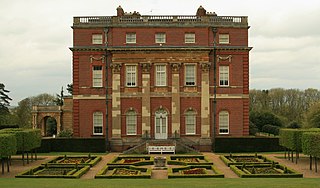
West Clandon is a village in Surrey, England within 1 mile of the A3. It is situated one mile north west of the much smaller separate village of East Clandon.
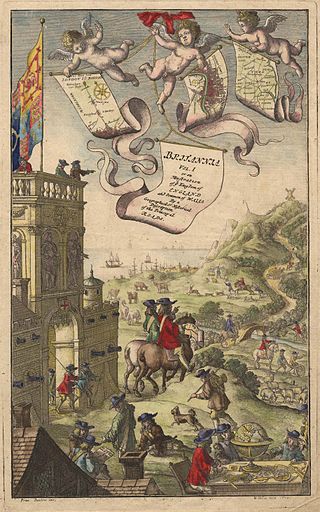
Francis Barlow was an English painter, etcher, and illustrator.

Painshill, near Cobham, Surrey, England, is one of the finest remaining examples of an 18th-century English landscape park. It was designed and created between 1738 and 1773 by Charles Hamilton. The original house built in the park by Hamilton has since been demolished.

Thomas Onslow, 2nd Baron Onslow, of West Clandon, Surrey, was a British landowner and Whig politician who sat in the English and British House of Commons between 1702 and 1717. He commissioned the building of Clandon Park House in the 1730s.
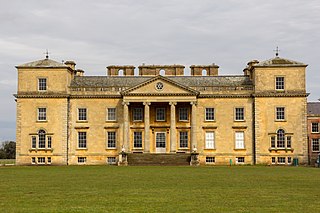
Croome Court is a mid-18th-century Neo-Palladian mansion surrounded by extensive landscaped parkland at Croome D'Abitot, near Upton-upon-Severn in south Worcestershire, England. The mansion and park were designed by Lancelot "Capability" Brown for the 6th Earl of Coventry, and they were Brown's first landscape design and first major architectural project. Some of the mansion's rooms were designed by Robert Adam. St Mary Magdalene's Church, Croome D'Abitot that sits within the grounds of the park is now owned and cared for by the Churches Conservation Trust.
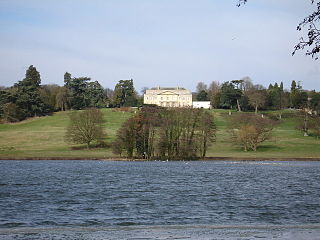
Gatton Park is a country estate set in parkland landscaped by Capability Brown and gardens by Henry Ernest Milner and Edward White at Gatton, near Reigate in Surrey, England.
Sir Richard Onslow was an English politician who sat in the House of Commons at various times between 1628 and 1664. He fought on the Parliamentary side during the English Civil War. He was the grandson of one Speaker of the House of Commons and the grandfather of another, both also called Richard Onslow.
Stiff Leadbetter was a British architect and builder, one of the most successful architect–builders of the 1750s and 1760s, working for many leading aristocratic families.

Richard Onslow, 3rd Baron Onslow KB was a British peer and politician, styled Hon. Richard Onslow from 1717 to 1740.

Wanborough Grange refers to an existing late medieval barn and formerly its surrounding monastic grange in Wanborough, Surrey, England.
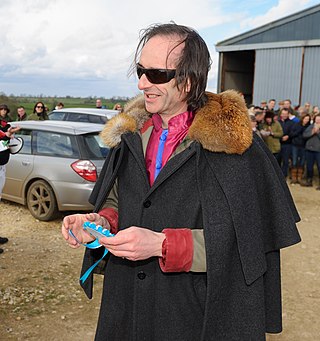
Rupert Charles William Bullard Onslow, 8th Earl of Onslow, known as Viscount Cranley from 1971 to 2011, is a British noble and hereditary peer.
The Manor of Papworth is located in the parish of Send with Ripley, Surrey, England. It has also been known historically as the Manor of Papeworth, Paperworth, Paperworth Court, and Papeworth Cross, among other names. Its history is intricately connected with that of the manors of Send, Dedswell, and West Clandon.
The Manor of Dedswell is located in the parish of Send with Ripley, Surrey, England. It has also been known historically as the Manor of Dodswell, Dadswell, and Dadswell Court. Its history is intricately connected with that of the manors of Send, Papworth, and West Clandon.





















